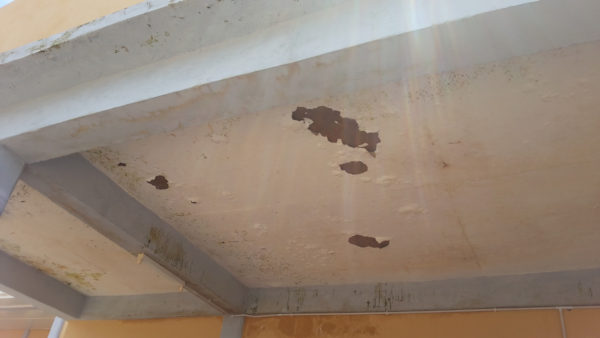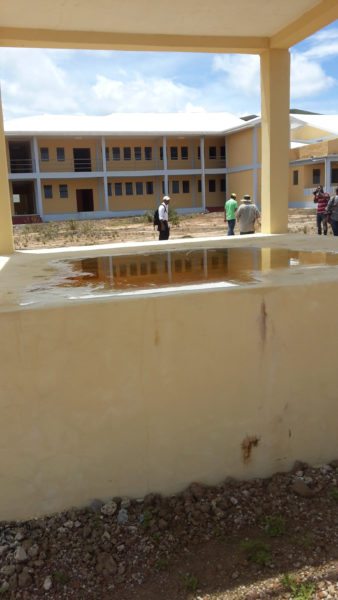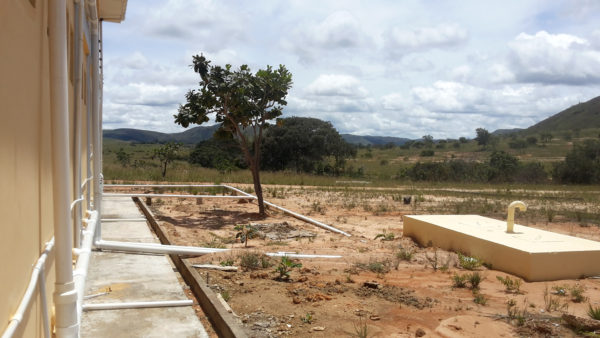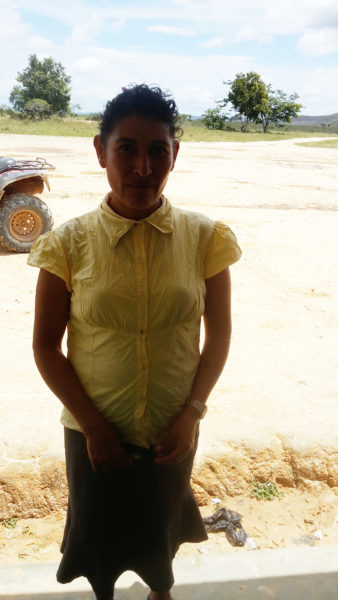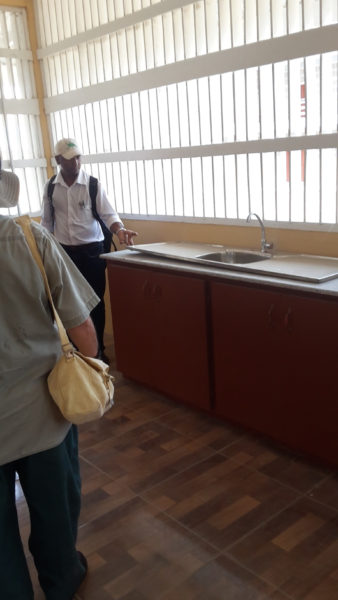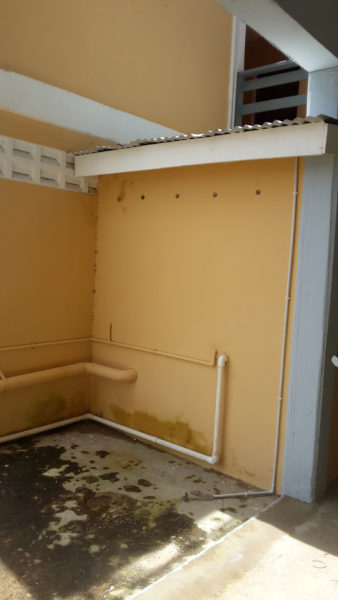At least $144 million would be required to fix the defective Kato Secondary School which was built at a cost of $728.1 million, according to auditing firm Rodrigues Architects Limited, who have also said that construction was rushed due to pressure from the former PPP/C government who wanted it to be completed in time for the May 2015 general elections.
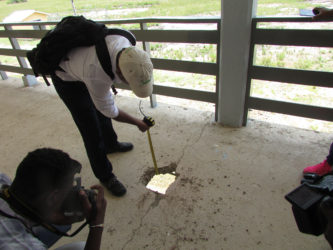
A tour by the Ministry of Public Infrastructure of the school complex yesterday in the Region Eight village showed evidence of poor construction with cracked and crumbling concrete floors and walls, steel protruding out of the walls, unstable safety bars, termite-infested wood, poor installation of equipment in the science lab, and cheap bathroom fixtures, among a number of other defects.
A technical audit report on the secondary school will be presented to the National Assembly today. “The report showed that this project was flawed from the design phase…” Public Relations Officer of the Ministry of Public Infrastructure Desilon Daniels told reporters yesterday.
“For now there is no set date for the opening of the Kato Secondary School but our main focus right now is just ensuring that the facility is hazard free and 100% safe for occupation by the children,” she added. Residents of Kato said they are anxiously awaiting word on when the building will be ready for occupancy.
The Ministry of Public Infrastructure yesterday facilitated a three-hour inspection of the school guided by representatives Albert Rodrigues and Devendra Doodnauth of Rodrigues Architects Limited. Also present on the tour was the Toshao of Kato village Clifton Pereira.
After the numerous defects were observed, Rodrigues said remedial works would cost an estimated minimum sum of $144 million. “Hopefully, if they can get some very quick action, I would say, hopefully by January, February next year…to the tune of about $144M that’s a ballpark figure because there are some things that have to be corrected and in so doing you might find out problems…” he asserted.
The construction company that built the school, Kares Engineering has said it is being wrongfully blamed for the school’s incompletion and alleged defects, as it met the required contractual obligations for the original sums provided.
Minister of State Joseph Harmon last month told the press that an evaluation done by the Ministry of Public Infrastructure found that the building was not safe enough to be occupied by children. The Kato school complex was built as a precondition for the investment of almost €1.8 million in European Union (EU) funding, for the proposed Kato Hydropower Project. The school was envisaged to be the main consumer of power supplied by the plant. The funding has since lapsed.
Kares Engineering had won the contract for the construction of the school with a bid of $691,972,139 back in 2013 and a timeframe of two years, from April 21, 2013 was given to have the construction completed.
‘Onerous’
Minister of Public Infrastructure David Patterson is expected to present the audit report on the school to the National Assembly today and the auditors say it will not only reveal major structural defects to the school but also show that there was political interference in the execution of works by supervisors and consultants of the project from the past PPP/C government.
“Going forward, the government has a very onerous task in getting that business in shape, as you can see the amount of defects that are there. What is sad is the expectations of the people, in terms of having their children out to school in September cannot be met and it would be foolhardy of the government to compromise the safety of the children now and putting them in a building that is not safe,” Managing Director of RAL Albert Rodrigues told Stabroek News.
“There has been a lot of compromising of standards. The supervising contractor DCSL said that they were pressured because the president and whoever said that they wanted the project completed for elections and they compromised their standards. They said so in their response to our report, that they could not have ignored instructions from such high authority. They said they don’t play politics but on this occasion they were given instructions from the president and ministers to the effect that they would like to see the work finished for elections. President (Donald) Ramotar was in office at the time. That is totally unacceptable because you cannot compromise safety with the expedience of time as requested by anybody and I think too much of the project was controlled by political gimmickry,” he declared.
‘Too many defects’
During yesterday’s visit, myriad visible structural defects were highlighted, and the audit team attributed the defects, among other reasons, to lack of professional competence, substandard materials used, inadequate supervision and even downright arrogance.
It was highlighted that there seemed to be a mix-up with the directional layout of the school and, as such, it was constructed in such a way that the classrooms were blocked from the wind by the sanitary block and the walkways.
It was also observed that steel used for the school’s foundation and walls were protruding through the seemingly weak concrete mixture, as when poked with one’s finger, the material would crumble and fall out.
Further, the trestles for the water tanks were not level resulting in water settling in one area and weakening the foundation. Moss grew in the pools of water. The settling seemed to have already started to wear the structure as the concrete has begun to loosen and crack.
When the concrete stairway of the main school building was checked, the safety bars were unstable and shook if held too firmly. Rodrigues pointed out that tests to the concrete itself revealed that the mixture used fell short of even the basic standard.
Further, while the tilework to the school’s science laboratory appeared to be well done, the lab sink was not properly installed but was simply rested on the granite countertop and could be lifted off with the bare hands while an unsteady faucet was attached.
This was how all the other kitchen sinks in the complex, at all the apartments in the teachers’ quarters, in the cafeteria’s kitchen and dining hall, were installed. The dining area seemed too small to accommodate the amount of students sitting to eat.
In terms of the bathroom facilities, one of the toilet tanks and a faucet at one of the face sinks were already broken and it was pointed out by Rodrigues that instead of using industrial fixtures, residential fixtures were used. “You know how children are with toilets, how can you use these things here,” he questioned.
Ventilation for the bathrooms is five one-inch PVC pipe holes in the walls which the auditor stressed was surely not enough. He said it was not made clear by the contractor as to why he chose that method. The septic system stands in the centre of the complex and it was pointed out that it has no drainage system. “So all you have here is just these sitting here with nowhere for anything to run,” he said.
Rodrigues also highlighted the quality of lumber and plywood used. It was evident that termites had infested the school and were feasting on its wooden structure. The holes in the wood of the floor of the upper level classrooms were not only caused by shrinking but from the termites.
The auditor reasoned that the contractor should have been aware of the quality and type of lumber and its susceptibility to termite infestation and possible shrinking which now compromises the strength of the wooden foundation and floors.
Rodrigues said that Kares displayed arrogance when contacted and offered very little information. “Not only inadequate but to some extent rude in that they have taken a very arrogant position. DCSL has from all appearances closed shop now but where Kares is concerned I don’t think they are going to find it financially viable to go back in there and I don’t think the government in public interest safety (could) have them back there because there are serious credibility issues,” he said.
Asked what he thinks the House should recommend moving forward, Rodrigues responded that “The House should give the minister ‘carte blanche’ to get the corrective works done…to put it bluntly ,the project needs a more hands-on approach now and Minister Patterson is the most competent to deal with the issue. He is open to guidance and getting a higher advice.
“For too long, the government, and I say the government in terms of structure and such, have been hung up on getting things done cheap without due regard for quality and competence. Hence you get people like Kares who can boast that he has done over 500 projects and only one he has to get a practical certificate for. That is totally unacceptable. There are contractual conditions that must be abided by. And unless you have a practical completion certificate then the defects liability period does not kick in and you cannot get your final payments,” Rodrigues asserted.
‘When?’
Residents said they can see the defects but need to know when the school would be functional.
“Everybody keeps asking me ‘Toshao you hear anything?’ and I can’t tell them anything because I myself don’t even know. People from Georgetown would come go check the school but no definite word on anything to us,” Pereira said.
“The secondary school at Paramakatoi is filled and they can’t take anyone else for this new September term so parents wondering what they have to do. Everyone from Kurukubaru, Kopinang , Waipa, Itabac, Kopinang…Monkey Mountain, Maikwak, Sandhill….Bamboo Creek and Mountain Foot, they want their children near to them and we want to know something, anything,” he added.
For 43-year-old mother of five, Marcia Fredericks, an answer is long overdue.
“Geralyn (her 12-year-old daughter) wrote the exams and they said like she will have to stay in the primary school because no one knows what is happening. First we heard 2015 and that came and gone. Then it was 2016 and that seems to be going too, we just want out children near to us. It is all we ask,” Fredericks said.
